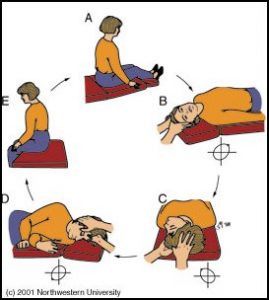Ear crystals and craniosacral vertigo are two different types of vertigo with different causes and different treatments. I am including ear crystals here is because I get so many inquires about it, and because many people are confused about the different forms of vertigo. Vertigo caused by structural restrictions in the skull usually causes spinning that last many minutes to hours. Ear crystals, on the other hand cause spinning that usually lasts only a matter of seconds, with perhaps some feeling of queasiness or discomfort for 10 to 20 minutes after the spinning stops. I have called vertigo that is caused by misalignment of the temporal bones of the skull (cranium) craniogenic vertigo. Re-positioning maneuvers used for crystals in the ear will not work for craniogenic vertigo, and craniosacral therapy will not work for ear crystals, so it is important to understand the difference.
BPPV
Vertigo caused by ear crystals is called Benign Paroxysmal Positional Vertigo or BPPV. BPPV is caused by calcium carbonate crystals in the semicircular canals of the inner ear. The crystals are actually debris that have migrated from another part of the inner ear where they do no harm into the semi-circular canals which monitor rotational balance. When you turn your head in the direction monitored by the one of three semi-circular canals the crystals move causing a momentary disturbance in the fluid movement within the canal resulting in vertigo. As the crystals settle the vertigo dissipates in about 30 or 60 seconds although there may be a longer period of queasiness or discomfort.
People suffering from BPPV often have trouble getting out of bed in the morning. However, if they try getting out of the bed on the opposite side they usually turn on they may find that they don’t get dizzy. Others may find that looking up or down or tilting their head to one side causes vertigo but if they hold their head still they do not get symptoms. These are all signs of particles in the semi-circular canals.
BPPV can be diagnosed largely by symptoms and confirmed with the DIX-Hallpike maneuver which involves tilting the patient backward on the treatment table, turning the head and observing eye movements called nystagmus
Patients sometimes tell me they have been diagnosed with “nystagmus” however, nystagmus is not a diagnosis or a disease. Nystagmus simply means eye movements. Doctors are able to differentiate different conditions by noting the specific characters of the nystagmus. Ear crystals creates a characteristic movement in the eyes when dizziness is provoked. So nystagmus is not the disease or the diagnosis but a diagnostic marker of the underlying problem causing the eye moments.
Treatment for Ear Crystals
The treatment of choice for crystals in the ear is the Epley maneuver. This is a positioning technique which literally moves the particles out of the semi-circular canals to another area where they do no harm and can be normally absorbed and excreted. The main drawback to the Epley maneuver is that every positional change causes vertigo, however it is highly effective and generally requires only a few sessions to be completely resolved.

The Epley maneuver is so easy to do that most people can do it at home without having to waste time and money paying for someone to do it for you. Patients report that it usually is completely successful in one or two sessions, although it may take longer. The elderly or others with physical limitations or who for any reason feel uncomfortable do the maneuver themselves should seek a professional skilled in the maneuver for assistance. There are many You Tube videos that demonstrate the maneuver both with a partner as well as self-maneuvers.
Many people have had good results with a newer exercise called the Half Somersault. It usually causes less severe vertigo but sometimes takes more repetitions.